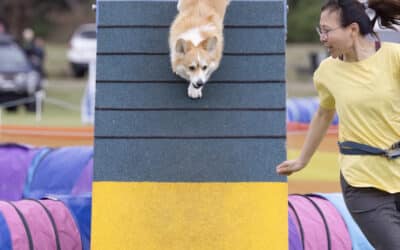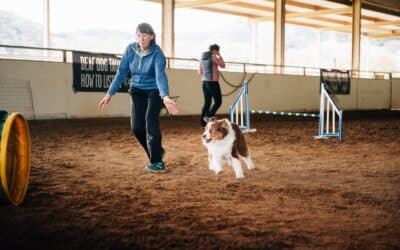Are you and your dog looking to master tight turns and collection in agility training? Does your dog seem to turn like a Mack truck, or blow you off and take off-course obstacles? Then this blog is for you, read on to learn more!
This blog is based on our popular, 30-minute on demand webinar on the same topic. You can access the webinar here and listen to OneMind Dogs Instructor Stephanie Williams as she breaks down the factors that influence collection and tight turns in dog agility.
Whether you’re new to Dog Agility or looking to sharpen your skills, this post and our webinar have got you covered with practical tips and demonstrations. Stay tuned as we recap the main points and offer some invaluable insights to take your agility training game to the next level!
Don’t miss our new Collection and tight turn Masterclass to master these skills: Collection and tight turn Masterclass
What is collection?
Before we delve into the ins and outs of teaching your dog to collect, it’s essential to understand what collection actually means and how it is relevant to achieving tight turns in dog agility. Collection is all about the adjustment of a dog’s stride while navigating an agility course. Dogs naturally adapt their stride in response to various course factors, and collection specifically refers to the shortening of this stride.
This adjustment is crucial for safety, particularly when your dog is approaching a jump. When your dog is prepared for a turn and has collected their stride, the obstacle performance will be much kinder on their bodies than blasting into the turn at full speed. Dogs can also execute much tighter turns by shortening their stride before the takeoff point. This skill is key in agility training, enabling your dog to manoeuvre through courses with greater precision and efficiency.
How to teach collection and tight turns in agility
Teaching collection is a vital part of agility foundation training to achieve tight turns later on. At OneMind Dogs, our instructors recommend teaching this skill to all dogs, irrespective of their innate jumping abilities. Our instructors use a range of specialized exercises designed to enhance how dogs approach and execute jumps. These exercises encourage dogs to use a diving-style jump over the bar, put their heads down when jumping, and efficiently use their bodies during the jump.
Our training methodology encompasses various handling techniques that cue collection. They include:
Human Arrow agility handling technique
The teaching stages of the Human Arrow focus on showing the dog how to use their body to jump in a diving-style jump; taking-off and landing close to the obstacle, leading to a tight and efficient turn. The key lies in the handler’s hand positioning and reward placement: with the elbow raised, palm facing upward, and knuckles directed towards the ground, the handler lures the dog into the correct position with a reward.
The handler’s proximity to the bar leaves little room between themselves and the obstacle, emphasizing the need for the dog to master a compact and controlled jump. As the dog becomes proficient in this style of jump, the handler gradually adds motion into and out of the turn.
Reverse Wrap agility handling technique
Reverse Wrap is an agility handling technique designed to create a tight and efficient wrap around the wing of a jump, when approaching from the backside. The teaching stages of Reverse Wrap encourage the dog to “Square-up” on approach to the jump when performing a wrap from the backside. Putting in an extra stride on the take-off side of the jump and jumping perpendicular to the jump as a result, leads to a more efficient wrap. The dog is also taught to use a diving-style jump that is kind on their bodies and allows them to accelerate easily towards the next obstacle after the turn.
The Jaakko Turn agility handling technique
Jaakko Turn is a dynamic handling technique used in dog agility to cue a tight turn or wrap on an obstacle when approaching from the front side. This technique is used when the handler wants the dog to continue on the same handling side after wrapping the obstacle.
In this manoeuvre, the dog turns around the wing of the obstacle, moving behind the handler’s back, and rejoins the handler on the same side as it approached the obstacle. By giving the dog early turning information using the Jaakko Turn, the dog has ample time to collect and turn tightly in a way that is safe for their bodies. This technique is excellent for high-drive dogs who have trouble slowing down to turn safely.
Front cross agility handling technique
The Front Cross handling technique involves a change of the handler’s side in front of the dog by turning towards them. This technique is critical when you need to change sides and cue collection at the same time. Because you are facing the dog, your body language automatically tells the dog to collect their stride and prepare for a turn.
The most common mistake with Front Cross is that the handler starts the cue too late, not giving the dog ample time to put in a collection stride. The Front Cross must be started at least one stride before the dog’s take-off point in order to get a tight and safe turn.
What cues collection?
This segment of our webinar on collection and tight turns in agility is undoubtedly one of the most critical, delving into the essential cues that signal collection to a dog during agility training. Below, we recap these cues briefly:
Rhythm change
The most significant cue comes from the handler’s physical motion. Dogs are highly responsive to their handler’s speed and tend to mirror it. So, when the handler speeds up, the dog will run faster and extend its stride. When the handler slows down, the dog follows suit, reducing its speed, adding strides, and collecting, often with an inclination to turn towards the handler.
Turning the chest laser toward the dog
This cue works in tandem with the movement of the handler’s opposite hand. For instance, if the dog is on the handler’s left side, lifting and raising the right hand will naturally rotate the handler’s chest towards the dog. This body language serves as a clear visual signal to the dog, typically prompting them to adjust their stride by adding steps and collecting, thereby preparing for a change in direction or an upcoming obstacle.
Moving toward the take-off point
This cue involves the handler aligning their feet, toes, and chest toward the dog’s take-off point. When these elements are pointed towards the take-off point, it signals the dog to collect, or shorten their stride, preparing for a precise and controlled jump. Conversely, if the handler points their toes and chest laser towards the landing site, the dog interprets this as a cue to extend their stride and go wide.
Lowered hand
Lowering the hand also serves as a cue. When the handler’s hand is lowered, it’s a natural visual signal for the dog to add strides, aiding in better collection.
Verbal cues
Alongside physical cues, verbal cues also play a role in helping the dog collect, especially when timed correctly. They complement the handler’s physical movements, reinforcing the desired behavior. For effectiveness, verbal commands and physical handling cues should work and be taught simultaneously.
What’s important when handling collection and tight turns in agility?
Here are the key aspects to consider for successfully cueing collection and tight turns in dog agility.
Timing
Dogs need ample time to perceive and respond to the handler’s cues. This means the handler’s signals must be visible to the dog at least a stride before reaching the takeoff point. Proper timing allows the dog to prepare adequately by shortening their strides, adding a stride, collecting, and executing tight turns.
Handling elements
All handling elements must synergize to cue collection effectively. This includes making a rhythm change at the right moment, positioning oneself a step away from the intended line, maintaining eye contact with the dog, orienting the chest laser and toes towards the takeoff point, keeping the hand low, and using verbal cues.
Connection
Maintaining a connection with the dog through eye contact is paramount. If you turn your head away to look in the direction you’re heading, you can confuse the dog, leading them to either bypass the obstacle, cross behind you or take a wider route.
Reasons why collection doesn’t happen in agility
Ever wondered why sometimes your dog doesn’t collect or turn as tightly as expected during agility training? Our webinar delves into this topic, identifying key reasons behind this challenge. Here are some of the main factors:
- The rhythm change happens too late or not at all
- Incorrect chest laser direction
- Lack of connection with the dog
- Failure to complete the handling technique on time
- Lack of adequate collection training for the dog
Sign up for our collection and tight turns webinar
Ensuring you and your dog master collection and tight turns requires patience, understanding, and plenty of practice. Don’t be discouraged if progress seems slow at times; every training session is a step forward.
To further enhance your skills and understanding, we highly recommend signing up for our webinar about collection and tight turns. Here, you’ll gain access to valuable video demonstrations and in-depth guidance that will transform your training sessions. Embrace the learning curve and join us at OneMind Dogs to unlock your dog’s full agility potential.



